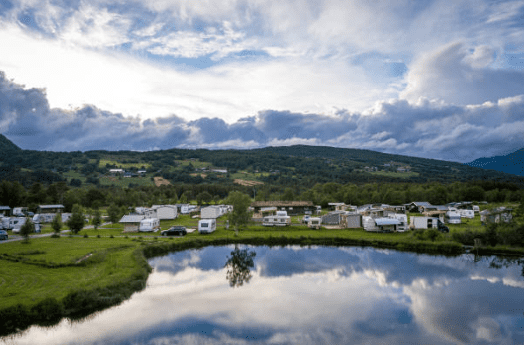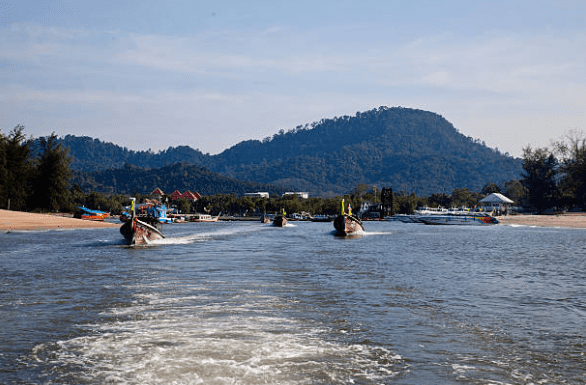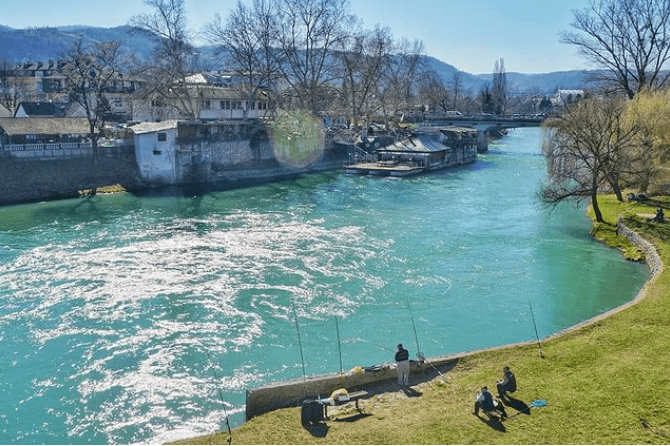Huh? Where’s that? Isn’t there a war going on?
The country of Bosnia and Herzegovina (yes, the name has two parts and even uses the word “and”) is located on the Balkan Peninsula in Southeastern Europe, though it’s actually more in the east. The war there ended a long time ago—over 20 years ago, in fact. If you still remember the Bosnian War, it means you’re probably as old as I am.

The history of this country is quite fascinating. For example, they have three presidents! Maybe one day, I’ll write about it in this blog. But for now, let me give you an overview of its amazing tourist destinations and a one-week itinerary.
Sarajevo

Sarajevo (pronounced: Sarayevo) is the capital of Bosnia & Herzegovina. Head straight to its old town, starting from Bašcaršija, which was built in the 15th century. Along the way, you’ll find restaurants, cafes, souvenir shops, and handsome Bosnian men. It’s definitely the place to see and be seen. Uniquely, within a small area, you’ll find a mosque, a Catholic church, an Orthodox church, and a synagogue all close to each other. Don’t forget to visit Vijecnica (City Hall), known for its stunning architecture and interiors. Inside, you’ll find the Sarajevo City Museum. Just 100 meters away is the Latin Bridge, the site of Franz Ferdinand’s assassination, which triggered World War I.
One of the proudest moments is visiting the Istiqlal Mosque. The name is indeed the same as the one in Jakarta because this mosque in Sarajevo was a gift from Indonesia to the people of Bosnia in 2001 as a symbol of solidarity and friendship between the two nations.
For a view of Sarajevo from above, take the cable car up to Trebevic, which is 1,627 meters high. When I was there in April 2019, it was still covered in snow. Walking to the Pino Nature Hotel for lunch was a bit challenging because the ice was super slippery. If you want to experience Bosnian nightlife (most Bosnians are Muslim and don’t drink alcohol), just drop by any shisha bar. The music is loud, but no one dances; they just sit, puffing on shisha while bobbing their heads.

Travnik
This former capital of Bosnia from 1699 to 1850 is just 1.5 hours from Sarajevo. The town is full of historical Ottoman-era buildings, such as houses, mosques, and a clock tower. Be sure to climb up to the fortress on the hilltop for a stunning view of the medieval town. As a writer, the highlight for me was visiting the house of Ivo Andric. He was a Yugoslav writer who won the Nobel Prize in Literature in 1961. His birthplace in Travnik has been turned into a memorial museum that showcases his life and works.
Jajce
On your way from Travnik to Bihac, make a stop at the town of Jajce, nestled between mountains. Its 22-meter waterfall, with emerald-green water and a backdrop of Bosnian houses, is simply stunning! Not far from there are the Mlincici water mills, built during the Austro-Hungarian era (1867-1918). These wooden houses use the river’s flow to power grain mills. Don’t forget to enjoy a coffee by Pliva Lake, with its blue water and snow-capped mountains in the background. Absolutely beautiful!

Bihac
From Jajce, have lunch at Etno Village Cardaklije, a 19th-century traditional Bosnian village complex set amid fields and forests. The food is traditional Bosnian cuisine, made with natural ingredients from its own farm, like bread, meat, and cheese. The traditional alcoholic drink Rakija, made from plums or pears, is a must-try with an alcohol content of 40-50%. Delicious!

A half-hour drive from there, you must visit Una National Park, located on the Croatian border. The dirt road leading in already treats you to stunning views along the blue river! Head straight to Štrbacki buk—a majestic, tiered 25-meter waterfall. Gorgeous!
In Bihac, stay at Hotel Opal Exclusive, which is located right on the banks of the blue Una River. All the rooms have balconies facing this beautiful river. Make an effort to wake up early to catch the magical sunrise. Another option is Hotel Natura Art, located in Una National Park. The building is designed in a traditional style, but what will really leave you speechless is the vast property right by the blue river, surrounded by forests—perfect for relaxing! You can also swim in the river or go white water rafting.

Banja Luka
The capital of the Republic of Srpska, which is predominantly Serbian, is also quite beautiful. The blue Vrbas River runs through the city, with many locals fishing and sunbathing by its clean waters. Have lunch at the Kazamat restaurant inside Kastel Fortress while enjoying views of the city. Oh, and don’t forget to try Teletina ispod saca—traditional slow-cooked veal under a hot metal lid. Absolutely delicious!

Then take a walk around the Old Town, visiting places like Saint Bonaventure Cathedral, the Orthodox Church of Christ the Saviour, Banski Dvor (Governor’s Palace), and the Ferhat Pasha Mosque. The most interesting place is the Museum of the Republic of Srpska, which covers history from the Stone Age to the Bosnian War. But the most chilling part is the horror display about the Ustaše concentration camps, dubbed the “Auschwitz of the Balkans” because of the hundreds of thousands of victims who were gruesomely killed, such as being sawed in half or boiled alive! I felt nauseous as soon as I left the exhibit!
Mostar
The most popular tourist city is Mostar, the administrative center of Herzegovina. It takes about 2 hours to drive from Sarajevo. The scenery along the way is incredibly beautiful, with turquoise rivers and layered mountains. The city itself is charming, centered around the iconic Stari Most bridge, which is a UNESCO World Heritage Site.

About an hour’s drive south of Mostar, you must visit the Kravice Waterfall. The wide waterfall is stunning, with bluish water! For Catholics, Medugorje, not far from the waterfall, is a must-visit. This is where the Virgin Mary is said to have appeared to six local children. It’s no wonder that Medugorje is now the third most visited religious site in Europe, after Lourdes in France and Fatima in Portugal.
Still in the area, stop by Pocitelj. This 15th-century town, set on the slopes of a karst hill by the Naretva River, is incredibly beautiful. Then, have lunch in Blagaj, specifically at the Etno House restaurant by the Buna River. The trout here is top-notch! A visit to Blagaj Tekke—a 600-year-old Sufi house located beneath a cliff by the blue river—is a must.

платформа для покупки аккаунтов магазин аккаунтов социальных сетей
продажа аккаунтов соцсетей marketplace-akkauntov-top.ru/
аккаунты с балансом https://magazin-akkauntov-online.ru/
маркетплейс аккаунтов профиль с подписчиками
профиль с подписчиками маркетплейс для реселлеров
магазин аккаунтов маркетплейс аккаунтов
биржа аккаунтов безопасная сделка аккаунтов
Account Purchase Guaranteed Accounts
Marketplace for Ready-Made Accounts Online Account Store
Ready-Made Accounts for Sale Verified Accounts for Sale
Account Catalog Account market
Ready-Made Accounts for Sale Database of Accounts for Sale
Secure Account Purchasing Platform Account market
Account exchange Accounts for Sale
Account marketplace Account Market
Online Account Store https://accountsmarketplaceonline.com
Account Sale Accounts for Sale
Account Exchange Service Online Account Store
sell account buy accounts
sell accounts account trading platform
account selling platform account market
account trading platform account exchange service
account exchange account trading service
profitable account sales account market
buy pre-made account accounts market
account sale profitable account sales
account selling service account buying platform
account trading platform secure account purchasing platform
account marketplace verified accounts for sale
account catalog account purchase
accounts marketplace https://accounts-buy.org/
account buying service account acquisition
account trading service account store
marketplace for ready-made accounts secure account sales
account acquisition account selling service
account selling platform website for selling accounts
website for selling accounts best-social-accounts.org
account acquisition account trading platform
secure account purchasing platform account trading platform
account exchange secure account sales
account purchase buy account
profitable account sales account trading service
gaming account marketplace ready-made accounts for sale
ready-made accounts for sale account trading service
account purchase social media account marketplace
account buying service account market
website for selling accounts https://accounts-offer.org
buy account https://accounts-marketplace.xyz/
buy accounts https://buy-best-accounts.org
account trading platform social-accounts-marketplaces.live
account trading https://accounts-marketplace.live/
purchase ready-made accounts https://social-accounts-marketplace.xyz
database of accounts for sale https://buy-accounts.space
sell accounts https://buy-accounts-shop.pro/
social media account marketplace https://accounts-marketplace.art
account marketplace https://social-accounts-marketplace.live
account exchange service https://buy-accounts.live
account exchange service https://accounts-marketplace.online
account trading https://accounts-marketplace-best.pro
площадка для продажи аккаунтов https://akkaunty-na-prodazhu.pro
купить аккаунт https://rynok-akkauntov.top/
купить аккаунт kupit-akkaunt.xyz
продажа аккаунтов akkaunt-magazin.online
купить аккаунт https://akkaunty-market.live/
биржа аккаунтов https://kupit-akkaunty-market.xyz
маркетплейс аккаунтов https://akkaunty-optom.live
купить аккаунт https://online-akkaunty-magazin.xyz/
покупка аккаунтов akkaunty-dlya-prodazhi.pro
продажа аккаунтов https://kupit-akkaunt.online/
cheap facebook advertising account buy a facebook account
buy facebook account buy facebook accounts cheap
buying fb accounts facebook ads accounts
buy fb ad account https://buy-ads-account.click
buy a facebook account https://ad-account-buy.top
buy facebook ads manager buy facebook advertising
buy facebook accounts facebook ad account buy
buying facebook accounts https://buy-ad-account.click/
buying facebook ad account buy fb account
adwords account for sale https://buy-ads-account.top
buy adwords account google ads accounts
facebook ads accounts https://buy-accounts.click
sell google ads account https://ads-account-for-sale.top
google ads accounts for sale buy google ads invoice account
adwords account for sale https://buy-ads-invoice-account.top
buy google adwords account https://buy-account-ads.work/
buy aged google ads account buy-ads-agency-account.top
google ads agency account buy https://sell-ads-account.click
buy verified google ads account https://buy-verified-ads-account.work
verified business manager for sale buy verified business manager facebook
buy google ads https://ads-agency-account-buy.click
buy facebook business manager accounts https://buy-business-manager-acc.org/
buy facebook business account buy-bm-account.org
verified facebook business manager for sale https://buy-verified-business-manager-account.org/
buy business manager account buy facebook verified business account
facebook verified business manager for sale business-manager-for-sale.org
facebook bm for sale buy verified facebook
buy verified business manager facebook https://buy-bm.org
buy verified business manager facebook https://verified-business-manager-for-sale.org
buy verified facebook https://buy-business-manager-accounts.org
tiktok ad accounts https://buy-tiktok-ads-account.org
buy tiktok ad account https://tiktok-ads-account-buy.org
tiktok agency account for sale https://tiktok-ads-account-for-sale.org
buy tiktok ads accounts https://tiktok-agency-account-for-sale.org
buy tiktok ad account https://buy-tiktok-ad-account.org
tiktok ads account buy https://buy-tiktok-ads-accounts.org
tiktok ads agency account https://buy-tiktok-business-account.org
buy tiktok ads accounts https://buy-tiktok-ads.org
buy tiktok ads accounts https://tiktok-ads-agency-account.org
Potential unwanted side effects of Dynabolon do exist, however this is amongst the most well-tolerated anabolic steroids of all time.
While side effects of Dynabolon are possible, most males
will discover the brink is very high. In truth, most healthy adult men can complement with this
or any Nandrolone steroid side effect free if they take the correct measures and
thoroughly perceive the hormone. In order that
will help you perceive the potential unwanted effects of Dynabol, we have broken them down into their separate classes together
with all the data you’ll want.
This, in flip, improves our circulation and total health, as well as our fitness
center efficiency. This means bigger pumps and extra endurance
during workouts, permitting you to complete extra units and reps than earlier than. As A Outcome Of
of this, the person only must administer one injection once every seven days.
In addition, this permits them to continue using Deca for almost 16 weeks while dealing with a negligible
amount of hazard. Any steroid can be utilized alone, but when it
comes to a steroid that has aromatizing properties like Equipoise,
then utilizing it alone is nearly positive to deliver about a state of low testosterone.
A Number Of high-profile professional athletes have tested optimistic
for Boldenone over the years, with drastic penalties for their careers.
Virtually all Boldenone brands are often faked or counterfeited, so
if you’re in search of genuine stuff, due diligence and a great amount of
research are required.
Collagen performs an essential function on the power
of tendons and ligaments, as well as an necessary function in cartilage and bone density.
It is also performs an integral position on the connective tissue
throughout the muscle tissue of the human body.
Collagen is a naturally produced protein and the first protein of all connective tissue.
With an enhanced fee of synthesis, there’s
merely extra available to do what it does finest.
This will play an important position on recovery and rejuvenation together with enhanced bone mineral content,
and is exactly why Dynabolon is so valuable to many athletes.
Dynabolon is a once popular anabolic steroid comprised of the active steroidal hormone Nandrolone attached to the very large Undecanoate
ester. Very similar to Nandrolone Decanoate (Deca Durabolin),
Dynabolon’s Undecanoate ester is slightly bigger offering a good longer lasting therapeutic window.
One of the key advantages of NPP is its capacity to offer joint ache reduction and enhance
collagen synthesis. This makes it well-liked amongst
bodybuilders who might expertise joint discomfort due to
heavy lifting and intense training. The typical traits and characteristics of
DHT derivatives/analogues are these of an elimination of any possible interaction with the aromatase enzyme, thereby
allowing all DHT derivatives to exhibit absolutely no estrogenic exercise what so ever.
The only exception to this case is Anadrol (Oxymetholone), the place it possesses a
excessive diploma of Estrogenic activity, but this is not
as a result of interplay with the aromatase enzyme – it can’t interact with
the aromatase enzyme. Anadrol instead displays mysterious properties whereby it and
its metabolites act as Estrogens themselves in varied tissues
in the body. But Anadrol is a particular exception,
not the rule.DHT derivatives possess extra versatility and adaptability in the preferred makes use of amongst bodybuilders and athletes than other
kinds of steroids.
Such symptoms can include a deepening of the vocal chords, clitoral enlargement and physique hair growth.
Whereas only mildly androgenic, the translating androgenic exercise appears to be
greater in girls than its structural rating implies.
Some girls can use this steroid without virilization symptoms if the dose is kept
low and use is short-term.
When choosing which anabolic brokers are most conducive to an athlete’s objectives the
following mechanisms must be taken into consideration, and compounds that are more heavily levered in the path of the desired effects ought to be favored.
To keep away from overcomplicating this article with minutia, I
will present a fowl’s-eye view of the primary mechanisms that drive athletic performance or
muscle constructing via exogenous anabolics. This just isn’t a
list of all drugs or health issues that work together with nandrolone.
Whereas that might be a compound best for somebody seeking
most hypertrophy with a relative lack of androgenic
unwanted effects like hair loss, on this state of affairs the
other is what we’d be taking pictures for. In 1955, when anabolic steroids
and weight loss (http://www.heritagegloves.com) with less androgens have
been developed, the nitrogen-balance technique was used once more
to gauge and evaluate the nitrogen-sparing effect of the various preparations.
“After 1935 the best methodology of discovering and measuring the protein-building motion of androgenic steroids in people proved to be metabolic steadiness studies. The next family in the anabolic steroid family tree is Dihydrotestosterone (DHT) and DHT derivatives. These two anabolics have been chemically designed to lack estrogenic activity and a capacity to drive vital positive aspects in mass, and be levered more towards pure protein expression and the neurological aspect of the spectrum. They all have sturdy influences on red blood cell rely, power techniques, and exhibit a hybrid of behaviors within the body analogous to how endogenous steroidogenesis would in any other case regulate balanced activity.
There can be speculation around whether or not sure Boldenone metabolites act as aromatase inhibitors and attenuate the estrogenic exercise of the parent hormone. Boldenone’s stage of estrogenicity is much less clear as there is no solid knowledge out there that provides particulars on its interaction with aromatase in people. In common, this class of compounds facilitates a center floor stage of muscle development, neurological results, and enhancement of cardio mechanisms. NPP shines when combined with Testosterone cypionate and Masteron or Winstrol for a lean, exhausting look, or with Dbol for loopy bulk and energy. Whether Or Not you’re chopping or bulking, NPP adapts to your objectives and delivers undeniable results. The infamous sexual side effects of Deca Durabolin embrace a lower in sexual desire and performance, which incessantly results in erectile dysfunction.
70918248
References:
famous athletes who used steroids (Chauncey)